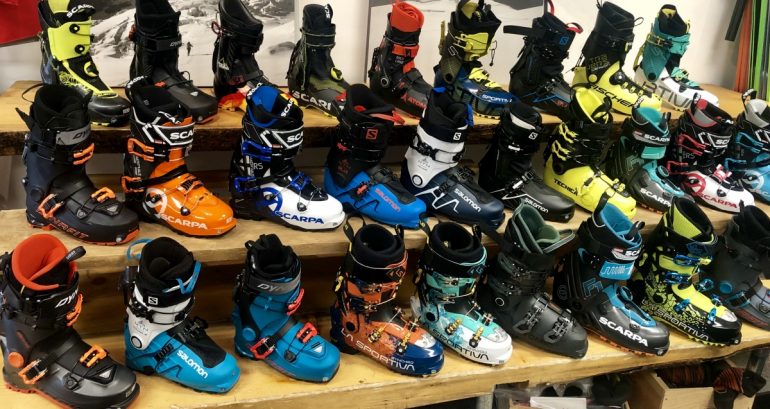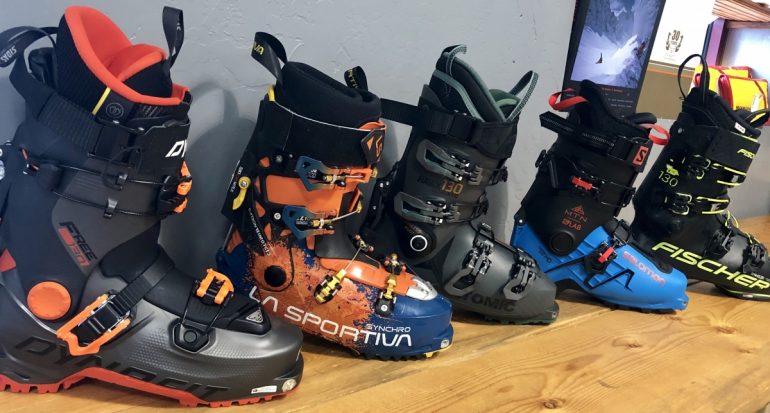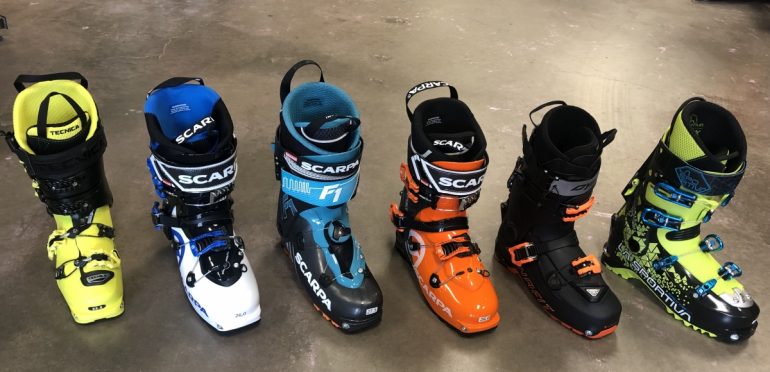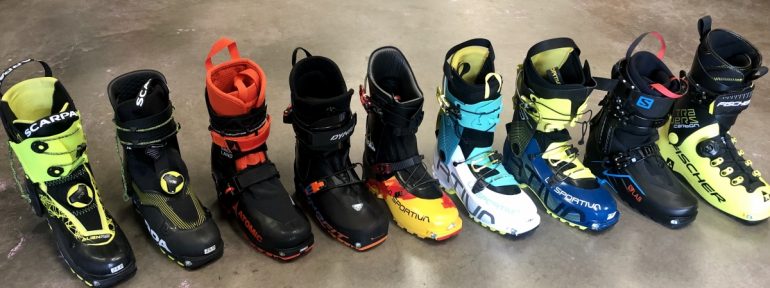Editor’s note: As part of our Tech Tuesday Tips, we refurbished this classic post with updates for the ’19/20 season. Please note that boot examples are just that, and not intended to be a complete listing of what’s available. Also, the lines between categories are blurring as ski boot innovation continues, so there is some wiggle room between these. Suggestions welcome, and stay tuned for Part II where we delve into materials.
New backcountry skiers often ask me for advice, and questions about buying AT (alpine ski touring) boots are by far the most common. Therefore I thought it would be useful to put together a comprehensive yet basic buying guide for AT ski boots. This aims to be an explanation of all the types of ski touring boots and boot features rather than recommending certain brands (though for our example boots we only use those with a good reputation). It’s targeted to those new to ski touring, but hopefully will find some use by everyone.
Fitting your ski touring boots
It’s tempting to buy a boot based on the latest features and hype (from WildSnow.com?), but fit is the most important factor when buying a new ski touring boot. A well fitting “shoe” will be more comfortable, warmer, and will ski better than one bought on the merits of features alone. Pressure points can be painful, or too much wiggle room will make even a stiff boot ski worse than a well-fitting softer boot (a reason “flex ratings” can be lame, which we’ll explore in the next post).
The shell of a boot (as well as the liner) is designed according to a “last.” This is the generic foot form that the boot is molded on. Different companies use different lasts. Because the shape of lasts vary, it’s difficult to buy your first-ever backcountry ski boots online, sight unseen. Instead, we recommend buying from a reputable shop so you can easily evaluate how the last of the boot fits your foot. Once you find a brand/last that works, it can possibly be the brand you pick for many years. (Find our reader-voted best ski shops here.)
If you’re new to the ski touring game, the best way to find the ideal match for your foot is to work with a bootfitter or a shop employee trained in bootfitting. We can’t emphasize this enough. They will evaluate your foot and point you to a boot that can accommodate your foot’s shape and any fit issues you have. Do not base your purchase on what fits your friends, or what a reviewer says “fit off the shelf,” or “felt great.” Those are not your feet.
After matching the shell to your foot, the next step is the liner. Many higher-end AT boots come with thermo-moldable liners that conform to your foot when heated. If your boots don’t have these, fear not. Intuition makes some of the best heat-mold liners on the market and they can be bought separately. More, boot makers are constantly improving liners that are intended to fit without heat molding. It’s possible that type of liner will work for you, so if the “non mold” option exists, ask the shop employee to help you explore it.
Personally, I can rarely ski a boot without first molding the liner.
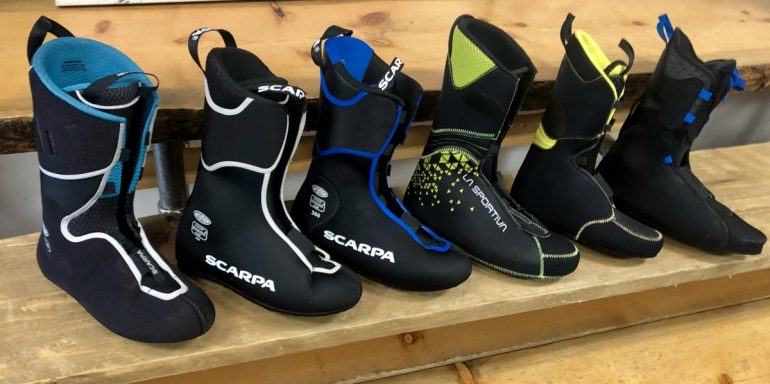
New high-end ski touring moldable liners. Intuition still leads the pack but many other companies are making great products.
In addition to the liners, some shells are now being marketed as heat moldable. For the most part this is a one way street to making your boots wider. If you are going to attempt this process consider downsizing when you buy your boots so you don’t accidentally end up with a boot too big. If you don’t go all in for a heat moldable shell, rest assured that many modern plastics are much easier to punch than the ski touring boots of years gone past.
Boot Categories
A vast variety of ski touring boots are available and the options continue to grow with the sport. They lie on a spectrum from ultra light race boots to heavier, stiff freeride touring boots and everything in between.
AT boots are always a compromise between the ability to ski well and walk comfortably. Boots that ski downhill the best are often heavier, more uncomfortable and inefficient for walking, but efficient touring boots may have less performance on the descent. Hence the huge variety in boots. This gap has shrunk and some newer boots ski almost like an alpine boot while offering excellent uphill efficiency. What kind of boot you want will be dictated mostly by how you plan to use it. Consider how much time you will spend at the resort vs. backcountry, your skiing style, and what type of touring you plan to do (e.g. powder, spring skiing, mountaineering, etc.).
Freeride Touring Boots put a priority on their ability to ski downhill well. These boots are basically alpine ski “overlap” boots with the addition of a walk/ski mode, rubber sole, and sometimes tech fittings that allow use with tech bindings such as Dynafit. Although these boots put the emphasis on the down, they are generally excellent for hiking. Polyurethane (PU, used in most alpine boots) is often the material of choice. Although PU “feels” like an alpine boot, its use commonly results in increased weight. However, freeride boots are starting to trend lighter. In the new class of 2019, some brands are incorporating carbon to stiffen up the shells, thus requiring less material and weight in the overall design.
Modern freeride AT boots rarely employ the use of interchangeable sole blocks, a feature that used to be required if you wanted to use your touring boot at the resort with your downhill bindings. Thanks to the advent of MNC (multi-norm certified) alpine bindings, tech fittings, rubber soles for walking and some slight sole rocker can now be accommodated. If you are targeting a boot with swappable sole blocks, it might be worth upgrading to a more recent design.
Freeride boots are recommended to those who will be skiing mostly on the resort and need one boot to do it all. Also, aggressive skiers who like a stiff boot will often use freeride boots even on long tours. Some examples:
New Freeride Touring Boots for 2019-20
Dynafit Hoji Free: 1575 grams (size 26), Retail: $899, Full Review
Scarpa Maestrale XT: 1515 grams (size 27), Retail: $899
Returning Freeride Touring Boots
Fischer Ranger Free 130: 1540 grams (size 27), Retail: $899, Full Review
La Sportiva Synchro: 1530 grams (Size 27), Retail: $759, Full Review
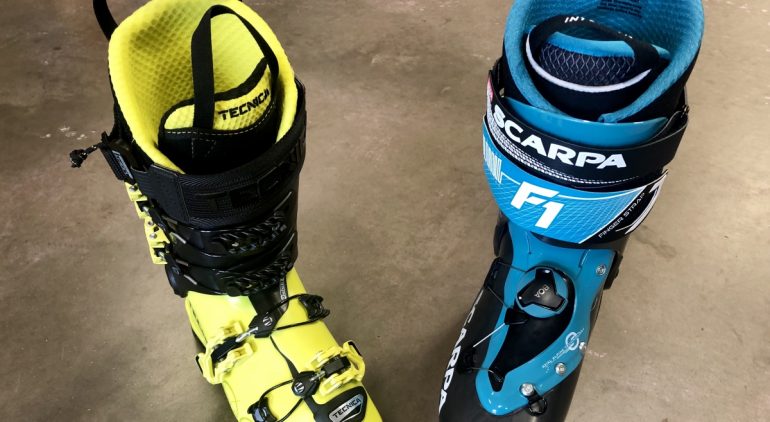
On the left, the Tecnica Zero G Pro Tour shows what a light “overlap” construction looks like, while the Scarpa F1 is the traditional touring boot “tongue” style.
All-mountain touring boots are the most common for ski touring, and what WildSnow.com readers are usually in. They generally have a traditional AT boot construction with a walk/ski mode, rubber sole, tech fittings, and lower cuff. Most use tongue construction, while some are overlap boots. “All mountain” may have a WTR (walk to ride) sole that works in frame bindings, MNC alpine bindings, as well as tech bindings. Exceptions include the Dynafit 8 and La Sportiva Spectre, which are popular all mountain boots without a WTR shaped sole.
As the name implies, this category of boots work very well for a variety of backcountry skiing. They are generally lighter than the freeride crowd while maintaining a fair amount of stiffness. However, they are aimed at efficiency for traditional ski touring and ski mountaineering, so they may not ski as aggressively as their freeride counterparts. Pebax is the plastic usually used in these boots, but higher-end models tend to use Grilamid (a nylon plastic) and other plastics that can be molded thin but still stiff to save weight. If you are planning on using the boot mostly in the backcountry and don’t mind sacrificing some downhill performance, these boots are a great choice. Be aware that this category is somewhat subjective, so our examples may overlap into other categories:
All Mountain Ski Touring Boots
Technica Zero G Tour Pro: 1315 grams (Size 26), Retail: $759, Full Review
Dynafit Hoji Pro Tour: 1450 grams (Size 27), Retail: $799, Full Review
La Sportiva Spectre: 1445 grams (Size 27), Retail: $679, Full Review
Scarpa Maestrale RS: 1410 grams (Size 27), Retail: $799, Full Review
Ski mountaineering race boots are ultra-light shoes designed for randonee “skimo” racing, although many people use them for standard ski touring as well as fitness uphilling. They place a high priority on uphill efficiency at the expense of downhill performance and/or price. In addition to the standard features of AT boots, ski mountaineering race boots usually include technical features such as innovative buckles or carbon-fiber construction. These boots often use Grilamid which is stiff, yet lightweight due to how thin the walls of the boot are (many say these boots don’t “feel” like an alpine boot’s flex, which is generally true. Achieving downhill performance with minimal material may require an extremely rigid flex). Race boots always have tech fittings. They often have a sole shape that will not function correctly in newer freeride touring bindings, such as the Fritschi Tecton, Salomon Shift or Marker Kingpin.
There are mixed opinions on the downhill performance of race boots. Many skiers feel race boots approach the stiffness of alpine boots, and use them for all their ski touring. The boots are indeed quite stiff, and ski strong, however they don’t quite have the “feel” of an alpine boot due to lack of progressive flex in the cuff and other more subtle factors. It’s an advanced hack to use race boots as general ski touring boots, but can be hard to resist because of their sheer uphill efficiency. However, they often save weight by being very low-volume, which can make them cold and difficult to fit. They are also often pricey.
A few race boot examples from different brands:
New Ski Mountaineering Race boots 2019-20
Scarpa Alien: 870 grams (Size 27), Retail: $699,
Returning Ski Mountaineer Race Boots
Scarpa Alien RS: 885 grams (Size 27), Retail: $869.95, Full Review
La Sportiva Sytron: 850 grams(27.5), Retail: $749, Full Review
Women’s boots are made by most boot manufacturers, and generally have a close equivalent on the male side of the line. They often share many of the same components and features as an equivalent men’s boot. However, they typically have softer flex, a slightly different fit, and of course different sizing. There’s nothing wrong with a woman using a guy’s boot, or vice versa. Women’s boots may lack stiffness, so some aggressive women skiers opt for men’s boots. Conversely some smaller guys might want the soft flex and smaller sizes of women’s boots. Women’s boots from various manufacturers:
Women’s Ski Touring Boots 2019-20
Scarpa Gea: 1250 grams (Size 25), Retail: $699, Full Review
Hoji Pro Tour Women’s: 1320 grams (Size 25), Retail: $799, Full Review
Bargain ski touring boots are offered by many boot manufacturers and are often a “dumbed down” version of higher-end boots. They are are typically made with polyurethane, and may lack features such as thermo-moldable liners and tech fittings. Bargain boots can be a good choice for someone on a budget or a beginner. However, many skiers will eventually want to upgrade to a nicer boot leading “bargain” boots to cost more in the long run. We don’t review bargain boots at Wildsnow since they are usually compromised clones of higher-end boots. An example of a bargain boot is the Dynafit Hoji PU, which uses less expensive PU plastic. With a non-thermo liner and sale price, this can be quite a value as it still includes tech fittings and a comfortable walk mode. Still, nearly every skier will eventually want thermo-moldable liners and less weight. Why wait?
That’s it for Part I of our comprehensive boot buying guide. Tune in for Part II when we’ll dive into common features and materials to help you determine which boot is best for you.
Louie Dawson earned his Bachelor Degree in Industrial Design from Western Washington University in 2014. When he’s not skiing Mount Baker or somewhere equally as snowy, he’s thinking about new products to make ski mountaineering more fun and safe.

